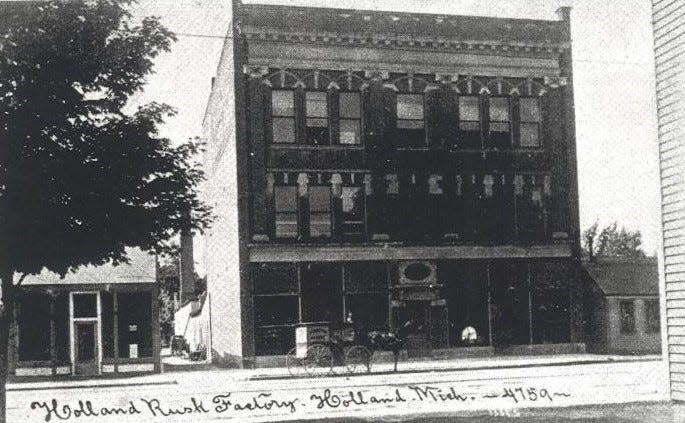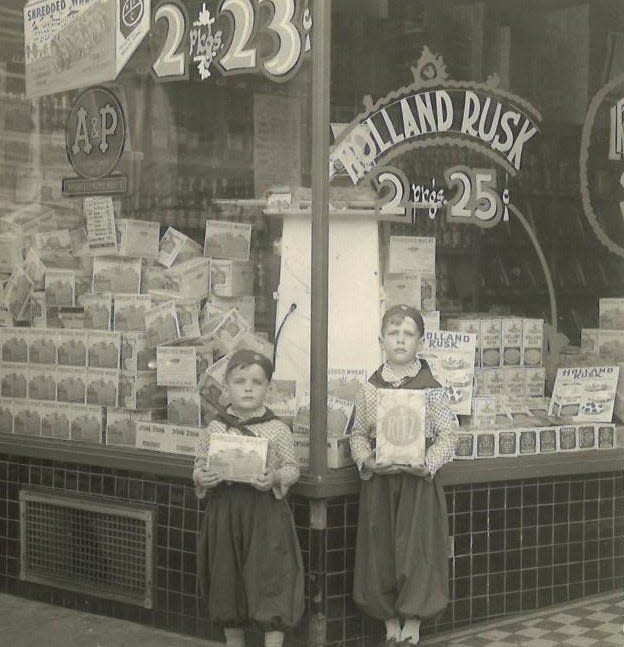Steve VanderVeen: The story behind Holland's 'rusks'

I vaguely remember eating rusk. When I was a little boy, my parents would serve the crisp brown biscuits, covered with strawberries or sugar and floating in a bowl of milk.
Rusk is a common international food, but with many varieties. The Dutch version of this twice-baked bread (the etymological meaning of “biscuit”) comes in rolls of 13 round discs. Berend Arendhorst may have been the first to manufacture it in Holland, Michigan.
Berend arrived in Michigan in 1890. A master baker, he came with a recipe his grandfather had developed in the Netherlands. By 1895, he'd produced large quantities in Grand Rapids, likely on the southwest side, before starting a business in Holland.
Here, he occupied a three-story building at 170-172 E. Eighth St. — with a retail shop on the ground floor and a one-story factory that ran to Ninth Street. Inside were ovens imported from England, which produced America’s "finest toast” for grocery stores and restaurants wrapped in packages labeled with a Dutch windmill.
By 1912, Holland Rusk employed 60 people, many of them women. By 1915, the factory was producing 200,000 biscuits per day!
World War I squeezed the business. In 1917, rusk and cookie sales were $100,000, but profits were a meager $718. To remain viable, in 1921, Berend and his sons William and John joined forces with a competitor, the Hekman Biscuit Company in Grand Rapids.
Edsko Hekman founded the Hekman Biscuit Company in 1893 out of necessity. Although he worked as a baker in the Netherlands, he hoped to become a furniture maker when he immigrated to Grand Rapids.
But the Wall Street Panic of 1893 killed his dream. To support his family, he went back to baking and peddled his goods door-to-door in the family’s baby buggy. That side business evolved into the Hekman Biscuit Company at 1363 Grandville Ave. It would become part of the largest biscuit company in the United States.

Edsko’s dream of becoming a furniture maker never left the family. In 1922, while running their biscuit company, Edsko’s three sons — John, Jelle and Henry — founded the Hekman Furniture Company, originally a maker of occasional tables.
In 1926, the Hekmans invested $10,000 in the Holland Rusk Company, which resulted in new machinery capable of producing 800,000 biscuits per day. But in 1928, the Arendhorsts and the Hekmans sold the Holland Rusk Company to the National Biscuit Company of New York.
Meanwhile, there were other competitors in Holland. In 1906, the Dutch Rusk Company briefly operated at 78-84 E. Eighth St. In 1905, Jacob and Edwin Heeringa, George and Gerrit Schurman, and William Beckman founded the Michigan Tea Rusk Company at 144-146 E. Eighth St.
Also in 1928, Jelle Hekman invested in the Michigan Tea Rusk Company. With the additional capital, the partners changed the name of their company to Dutch Tea Rusk, sold their retail shop, and built, in 1929, a $20,000 bakery at 418 W. 18th St. (at Cleveland Avenue).
There, new ovens baked 350 biscuit loves every 40 minutes, which required 30 railcars of flour per year and six trucks to deliver the biscuits to local independent grocery stores.
Subscribe: Get unlimited access to our local coverage
In 1945, the Dutch Tea Rusk Company became Hekman Rusk. By 1947, Jelle and John Hekman fully-owned the business. They built a new bakery on Columbia Avenue at 11th Street. In 1964, the Hekmans increased their Holland presence when they purchased the Dutch-Boy Bakery at 190-192 E. 11th St. and other commercial bakeries in Holland.
They sold the Dutch-Boy Bakery in 1973. Hekman Rusk lasted until 1979.

Meanwhile, in 1948, under John Hekman, Hekman Biscuit tripled its production, employing 450 people. Hekman Biscuit became part of Keebler in 1960, which became part of United Biscuit in 1974 and then Kellogg in 2001.
In 1970, the Hekman Furniture Company became part of Beatrice. In 1983, Howard Miller purchased Hekman Furniture.
Information for this story comes from Robert Swierenga’s "Holland, Michigan," Rapid Growth Media, Find A Grave, Newspapers.com, Furniture Today, The Washington Post, Wikipedia, Hekman and the Holland City Directories.
— Steve VanderVeen is a resident of Holland. You may reach him at skvveen@gmail.com. His book, "The Holland Area's First Entrepreneurs," is available at Reader’s World.
This article originally appeared on The Holland Sentinel: Holland History: The story behind Holland's 'rusks'
